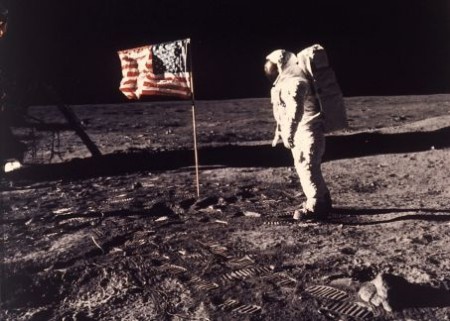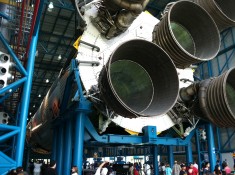Lately, leaders seeking to describe a bold effort to make massive change have used the metaphor of the moon shot, notably including Arne Duncan, early in his tenure as Secretary of Education. At the outset of the stimulus, the moon mission offered an apt metaphor for reaching a goal that has long seemed unreachable, through determination, hard work, and vision.

I was thinking about those words today as I visited the Kennedy Space Center, the nation’s diving board into space for the last five decades. (I was in Florida for the inspiring KIPP School Summit, and being a space nerd pretty much since birth, couldn’t resist the side trip.)
I’m not normally one for organized tours of anything, and if they involve a bus and a PA system, I’ll assuredly find something else to do. But the Space Center tour was oddly moving—less so for the visit to the now-grounded Atlantis space shuttle, much more so to the Firing Room, where launch control from the Apollo missions has been preserved perfectly since 1973. Before you enter, you pause for a few minutes in a theater. As Motown plays, an artfully constructed movie teaches not just about the program itself, but the social and historical forces that made reaching the moon a turning point, a vital proof of what was best in us as a nation. At a moment of war and worry, John Kennedy set before the country a task of outlandish ambition, and told us we would do it because it was hard. He said:
We choose to go to the moon. We choose to go to the moon in this decade and do the other things, not because they are easy, but because they are hard, because that goal will serve to organize and measure the best of our energies and skills, because that challenge is one that we are willing to accept, one we are unwilling to postpone, and one which we intend to win …
But if I were to say, my fellow citizens, that we shall send to the moon, 240,000 miles away from the control station in Houston, a giant rocket more than 300 feet tall, the length of this football field, made of new metal alloys, some of which have not yet been invented, capable of standing heat and stresses several times more than have ever been experienced, fitted together with a precision better than the finest watch, carrying all the equipment needed for propulsion, guidance, control, communications, food and survival, on an untried mission, to an unknown celestial body, and then return it safely to earth, re-entering the atmosphere at speeds of over 25,000 miles per hour, causing heat about half that of the temperature of the sun–almost as hot as it is here today–and do all this, and do it right, and do it first before this decade is out–then we must be bold.
It was also, as Kennedy noted, expensive. The cost of the moon missions was about $5.4 billion in 1962, which translates into about $42 billion today. (Race to the Top, the big fund that Duncan talked about as his moon shot, was around $5 billion when it began in 2009.)
And so, we set out to put men on the moon.
The movie over, it was on to the firing room, where sound, video and even a bit of shaking floor simulated the sights, sounds and feeling of the launch as the controllers experienced it. And finally, to a vast hall where a fully functional Saturn V rocket is broken into sections, a gleaming white thirty-story skyscraper laid on its side, from thrusters the size of the house at its base to the tiny manned capsule at the tip. Seeing it, it’s hard not to wonder at the trust the men in that capsule must have had in the engineers, who with slide rules and protractors devised the tube of fuel, powerful as an atomic bomb, on top of which the capsule sits.
 I was born the year the Apollo missions began, and one of my first memories is of Walter Cronkite announcing the launch of a rocket to the moon. Yet until today I’ve never appreciated the magnitude of what we set out to do. It’s easy to imagine the objections: “But to get humans to the moon, we’d have to build a tower of liquid fuel the size of a Manhattan apartment building, inside a construction shed with massive cranes and the tallest door in the world, and drive it three miles on a moving platform that can hold 6 million pounds. The rocket would have to fly perfectly straight but come apart in sections—engineering marvels which you’d have to discard like empty cans after they’d done their job just once. You’d have to flood the base of the launch pad with 300,000 gallons of water to keep the blast from shaking the rocket to pieces before it ever got off the ground.
I was born the year the Apollo missions began, and one of my first memories is of Walter Cronkite announcing the launch of a rocket to the moon. Yet until today I’ve never appreciated the magnitude of what we set out to do. It’s easy to imagine the objections: “But to get humans to the moon, we’d have to build a tower of liquid fuel the size of a Manhattan apartment building, inside a construction shed with massive cranes and the tallest door in the world, and drive it three miles on a moving platform that can hold 6 million pounds. The rocket would have to fly perfectly straight but come apart in sections—engineering marvels which you’d have to discard like empty cans after they’d done their job just once. You’d have to flood the base of the launch pad with 300,000 gallons of water to keep the blast from shaking the rocket to pieces before it ever got off the ground.
“You’d have to fit another whole spaceship inside the first one to actually land on the moon. And the manned capsule would have to be made of some material that would keep it from turning into a brightly burning meteorite on reentry. Oh, and if any of about twenty thousand pieces didn’t work, you’d kill the brave men sitting at the top of this towering bomb in an internationally televised funeral pyre.
“Also, the whole project would require an unprecedented partnership between government, nonprofit management, and private enterprise.
“What I’m saying is, it’s just not going to happen.”
It happened.
So, when Arne Duncan talks about our moon shot in education, I get it a little better now. Weirdly, defeatism is much in vogue these days in education. A growing chorus would shift the conversation, suggesting that the link between poverty and rotten educational outcomes is an immutable fact, rather than the problem to be solved. The variable becomes the constant. It can’t be done, because it’s really hard.
Maybe it’s just that the optimism of KIPP’s 3,000-teacher celebration has infected my sense of proportion and possibility. But I think there’s a connection between last night at KIPP School Summit and Kennedy’s moon shot challenge. At the KIPP gala, keynoter Bill Clinton urged us to find ways to give every child the remarkable opportunities that KIPP students enjoy. I hear an echo of Kennedy, urging us to burst gravitational bonds we once believed immutable and to take on a task once thought impossible, within a decade. He urged us to the moon because this country is at its best when it takes on hard, important tasks, and because he knew that we had the capacity to succeed. That, I think, is what Clinton was telling us about schools and underserved kids last night. That’s what Arne Duncan’s moon shot means. And, by any reasonable standard, educating all of our kids well is a hell of a lot more important than reaching the moon–whether you judge by international competition or moral imperative. (Maybe, today, we ought to be thinking of this as our Mars shot.)
It was very, very hard to get to the moon. Many doubted it was possible. But when we put our best minds, our hard work, and our full commitment to the task, we succeeded.
Are we not still that country today?